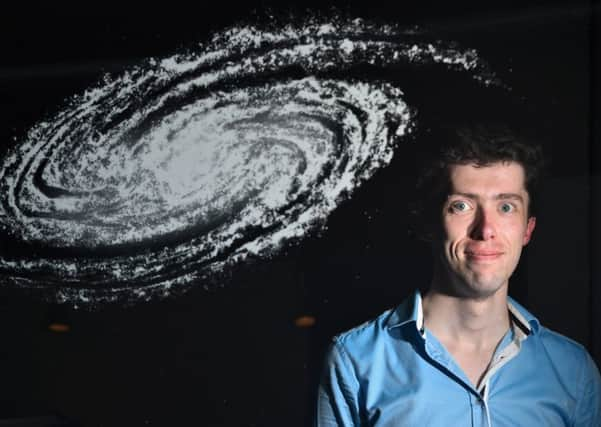Review: Glasgow School of Art Degree Show 2015


Howieson’s work, bright perspex letters on a simple adjustable board, has been conceived to offer a clearer way round the place on a daily basis, but also to be flexible at times of crisis and change. You can’t help but feel there is a wider context to the project. Since the shocking fire in the historic Mackintosh Building opposite on 23 May last year, students and staff have found themselves having to navigate their buildings, their assumptions and their education anew.
The restoration is now gathering pace. It is clear one year on that GSA staff, under director Tom Inns, have responded to the disaster with sensitivity and efficiency. The support of last year’s graduating students through the Phoenix Bursary scheme to help support those whose degree shows were affected by the fire and the relocation of Fine Art students from their famous studios to the Tontine Building on the Trongate has done much to steady the ship. You can’t deny the sense of loss, however. Something is missing and it is there in the fragile hulk on Renfrew Street now being slowly nursed back to life.
Advertisement
Hide AdThere are some 600 students graduating across all departments at GSA this summer. Howieson is a Communication Design Student and part of a fabulously strong cohort. You get the sense these young designers are being taught to think critically and inventively, not just pragmatically. Alan Knox’s Universal Sympathy is a series of swirling astronomical images that turn out to be photograms of his beloved grandfather’s ashes, a void at the centre of one image presenting the black hole of emotional loss.
Illustration student Poppy Nash, who is also a type 1 diabetic, has turned the daily grind of injections and monitoring into lively printed textiles used to create hats from bar graphs and an outfit with special pockets for her blood testing and injection kits. The latter’s dizzying pattern of numbers is drawn from her blood sugar stats. Dawn McCance is clearly the cynic of the bunch, a hanging garment is an invitation to visitors to don the cloak of pretence. A series of delightful typographical posters, which might be marketing for gigs, albums or the latest fashion brand, turns out to be sinister. Her sly rendering of the hate-filled propaganda of the notorious Westboro Baptist Church, whose protest placards say things like ‘pray for more dead soldiers’, is designed to draw you up short should you confuse the medium with the message. The name of her project? Offensively Trendy Graphic Design.
At the Tontine, Fine Art students have done their best to cope with their new surroundings. As is often the case the most successful projects are those which are conceived as one-room installations around a tight theme. I loved Emily Penn’s launch of the Middle Class Party, complete with campaign office, party political broadcast and election leaflets that promise “We will help you maintain your tasteful lifestyle.” One can’t help but notice that Penn’s electoral haircut and besuited appearance fall bang in the middle between Yvette Cooper and Ruth Davidson.
Similarly, Charlotte June Sammons has turned experience of a depressive disorder into a series of book and video works, which are housed in a seamless recreation of a health service waiting room. There are leaflet racks, pinboards with information, drawers filled with self-help books and a website with a YouTube playlist of depressed musicians. On a low table the artist has placed a self-made book entitled Cud. It has been comprehensively chewed.
Other presentations are loose and playful. Jamie Limond’s paintings are made on that thick vinyl fabric that you get in children’s soft play areas. Their apparent cheerful simplicity belies their sophistication. Melanie Viksell’s little clapboard church is on rockers, provoking all sorts of questions about what it is for or what it might contain. Is it a rocking horse perhaps, or a Trojan house? Jessica Kelly’s massive cylindrical sculpture turns out to be a giant kaleidoscope big enough to walk into. I loved Louisa Winning’s series of three short films inspired, I think, by the cheerful collage style of the rising British artist Heather Phillipson. It’s fine at this stage of your life to wear your influences and your heart on your sleeve. Winning’s funny, surreal trilogy the Principles of Human Knowledge would have been massively labour intensive for all its effortless charm, a series of funny monologues featuring giant asparagus tips, a pair of rabbits and a bemused male protagonist who is all mouth and y-fronts and no trousers.
Trousers were amongst the best things on display at this year’s Fashion degree show. In what can be an anxious time for young people, one of my favourite presentations revealed a devil-may-care attitude to design. Luis M Sanchez Garzas presented an outrageous collection drawn from vibrant and leafy household furnishing fabrics, DIY materials and the judicious use of green plastic door handles.
Advertisement
Hide AdInterestingly much of the fashion responded to some of the tougher issues of the day, such as trauma and disruption. The slick and outstanding presentation from Jonathan Douglas, the young Balloch designer who is now headed for global fashion group PVH, owners of Tommy Hilfiger and Calvin Klein, was utterly wearable menswear. But his foil trousers and paint block monochrome suit evoked both traditional workwear and protective gear. One can’t help but suspect that the ongoing practical work of conservation and restoration at the Mackintosh is influencing the zeitgeist.